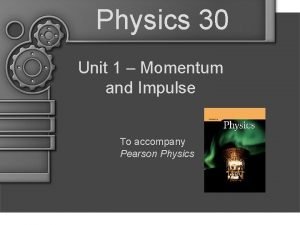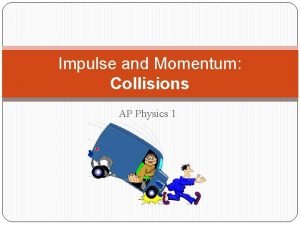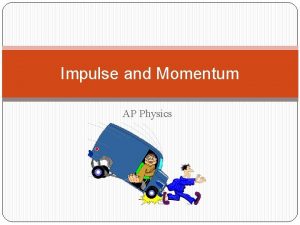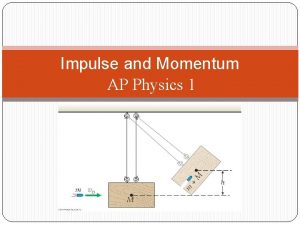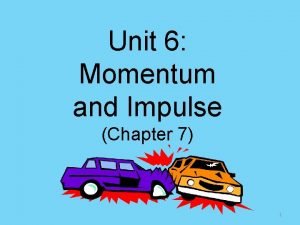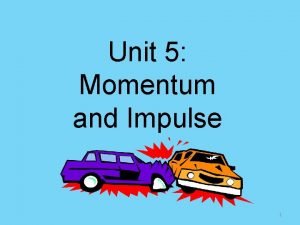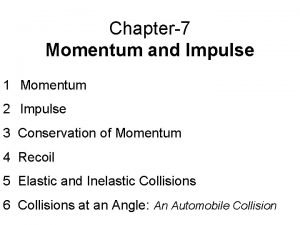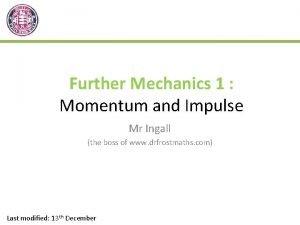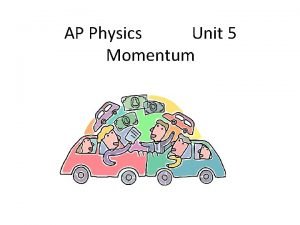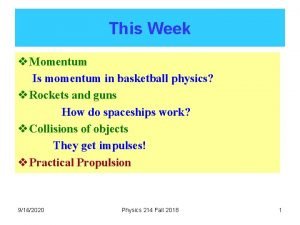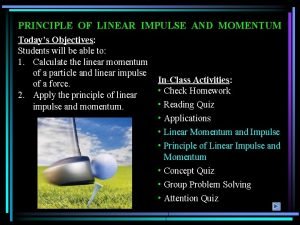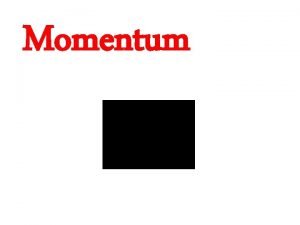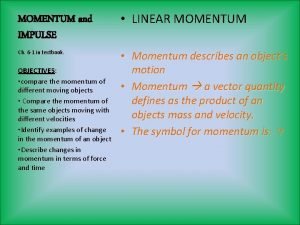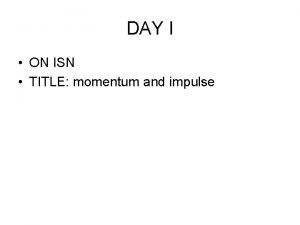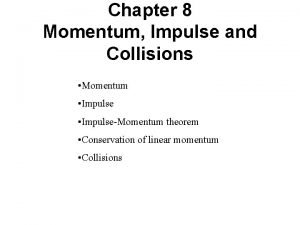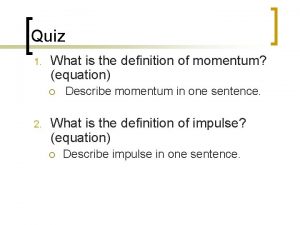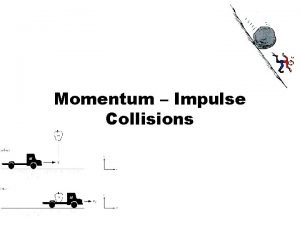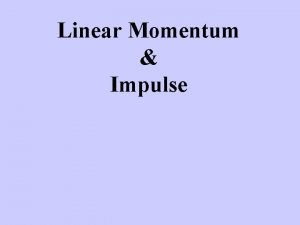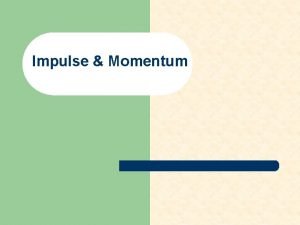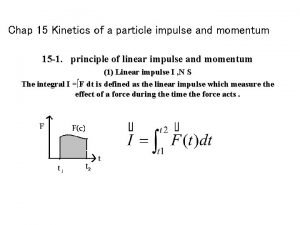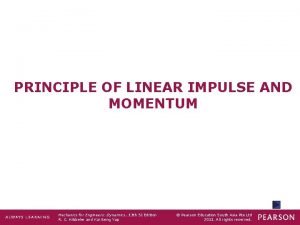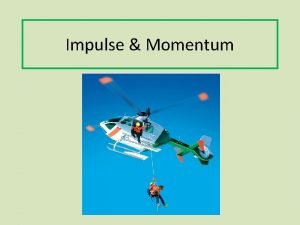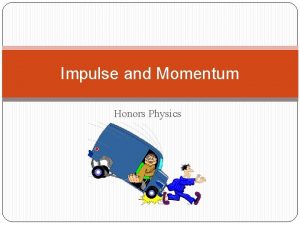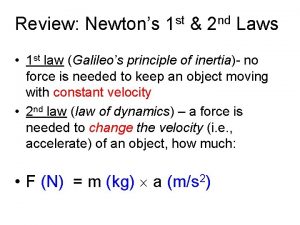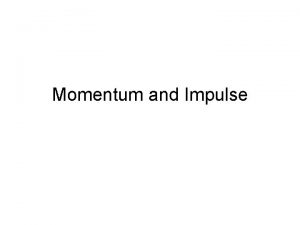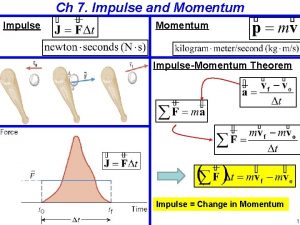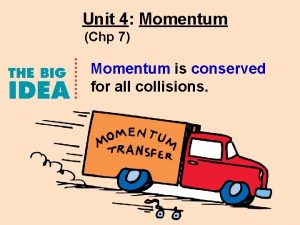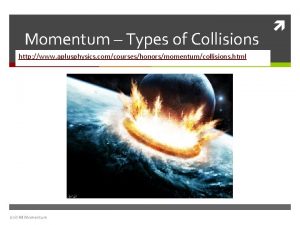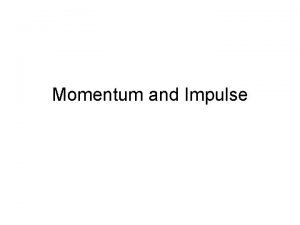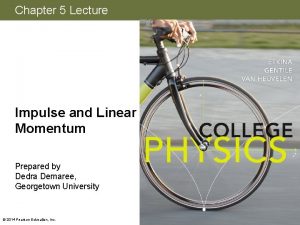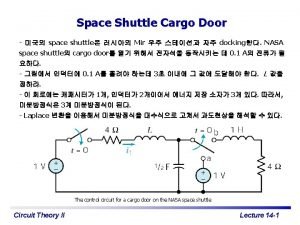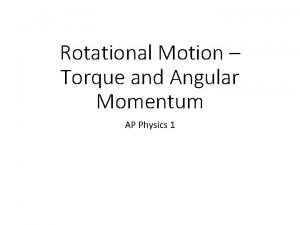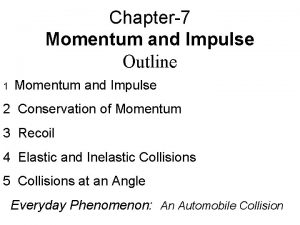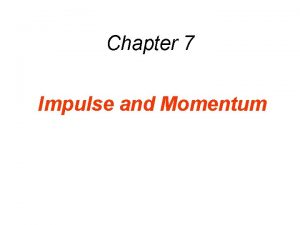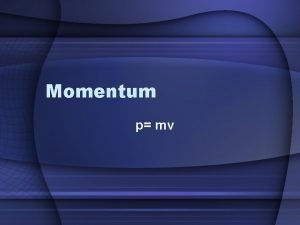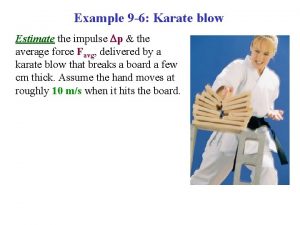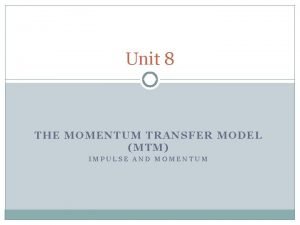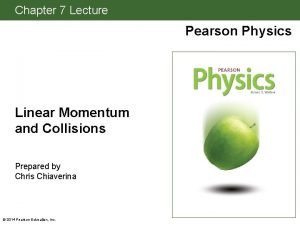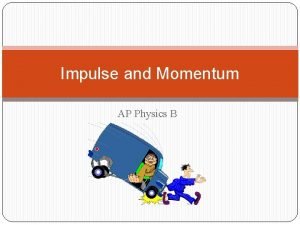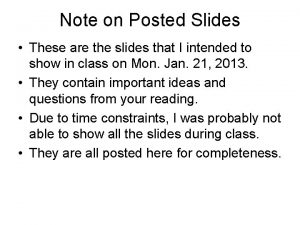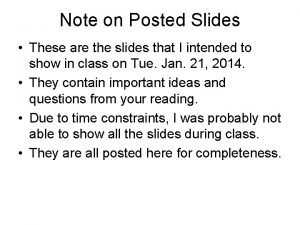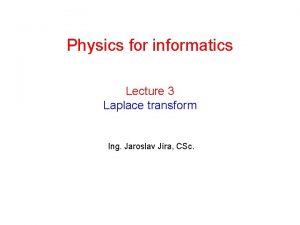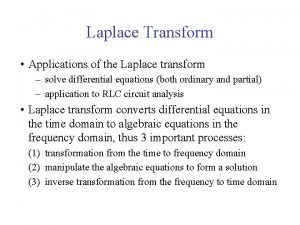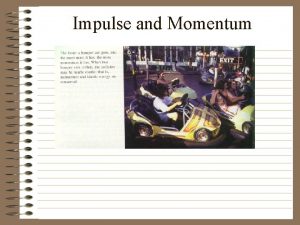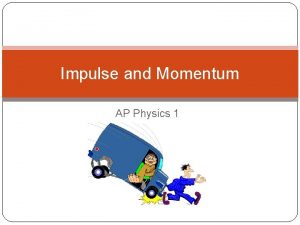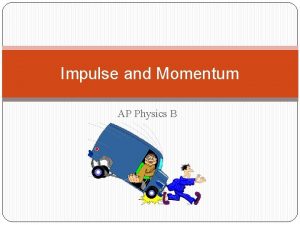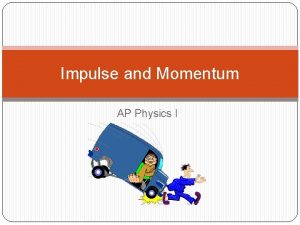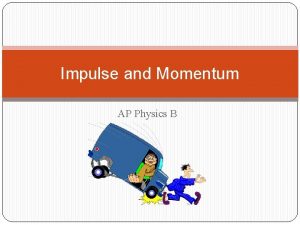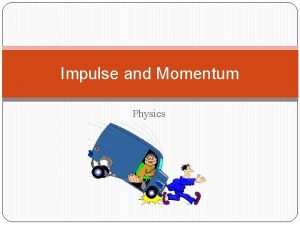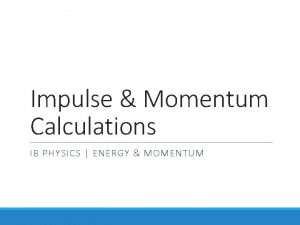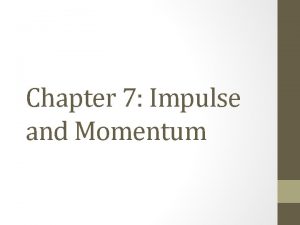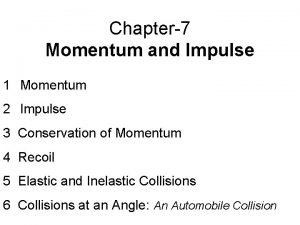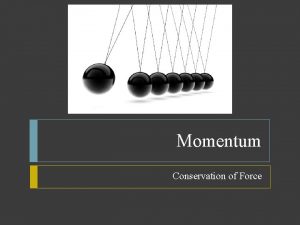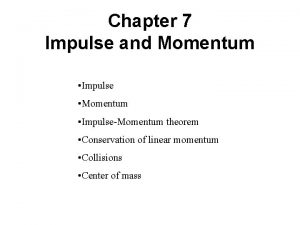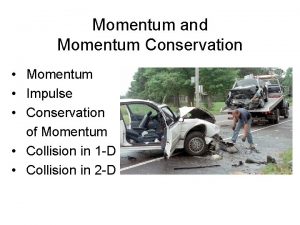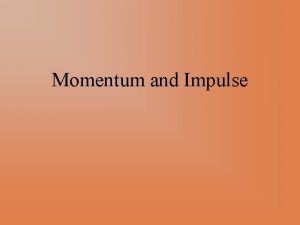Physics 30 Unit 1 Momentum and Impulse To





































![Momentum : 2 d Collisions • First change 12. 0°[E of N] to 78. Momentum : 2 d Collisions • First change 12. 0°[E of N] to 78.](https://slidetodoc.com/presentation_image/5e33f69c66f3b90fa1fa2ef3840b1888/image-38.jpg)

















- Slides: 55

Physics 30 Unit 1 – Momentum and Impulse To accompany Pearson Physics

Momentum • “quantity of motion” - Newton • is the product of mass and velocity • Is a vector, • has units of

Momentum • Newton’s 2 nd Law, rewritten as , can be as your text shows on page 450. We’ll use this later to determine a quantity called impulse • Try Practice Problem 1 page 451

Momentum Practice Problem 1, page 451: • m = 65 kg + 535 kg = 600 kg Since velocity is a vector, direction must be given along with the numerical answer as shown on page 451

Momentum • Momentum “varies directly as” or “is directly proportional to” both Study Example 9. 2 page 452 • Try Practice Problem 1 page 452

Momentum • Practice Problem 1, page 452

Momentum • Do questions 1 – 3, 5, 6, 8, 9, 11 page 453

Momentum and Impulse • Quick Lab 9. 2 page 455 (discuss or do and discuss) • Earlier you saw that Newton’s 2 nd Law could be rewritten as: This equation can be rewritten as:

Momentum and Impulse • The change in momentum is equal to the net force times the time for the change, This quantity is called IMPULSE and is equal to the change in momentum

Momentum and Impulse • Since , For a given change in momentum (or change in velocity if mass is constant), a fast change will mean a large force while a slower change will mean a smaller force

Momentum and Impulse Practical applications? • cushioned soles on runners • airbags • crumple zones in cars • others? Additional examples p. 463 - 465

Momentum and Impulse • Units of impulse: • Units of momentum: Since impulse = change in momentum, these units must be same. Your text shows this on page 457.

Momentum and Impulse • Direction of Impulse? ? ? Same as the direction of the change of momentum If you are travelling west in a car at constant speed, and hit the brakes, Impulse is east If you are travelling west in a car at constant speed, and step on the gas, Impulse is west

Momentum and Impulse • Try Practice Problems 1 and 2 page 458

Momentum and Impulse • Practice Problem 1, p. 458

Momentum and Impulse • Practice Problem 2, p. 458 Since velocity is a vector, it is necessary to take direction into account when determining change in velocity

Momentum and Impulse • When the net force is not constant, the impulse can be calculated by finding the area under an F vs t graph • Your textbook has a number of examples on pages 459 – 461 • Discuss golf ball graph page 462

Momentum • Review Example 9. 4, page 462 • Do Practice Problem 1, page 462

Momentum and Impulse • Practice Problem 1, page 462 c) a) A 1 A 2 b) Impulse = total area = A 1+A 2

Momentum and Impulse • Do questions 1, 2, 4, 7, 8, 9 b, 10, page 467

Momentum: 1 d Collisions • Note that in collisions friction is present as a constant force before, during, and after the collision • Since collision times are relatively short, friction can be ignored in collision questions provided you are using only momentum of the objects immediately before or after the collision • This will always be the case for you

Momentum • Lab 9. 5 page 471

Momentum : 1 d Collisions • Law of Conservation of Momentum: When no external net force acts on a system, the momentum of the system remains constant • Review pages 474 – 479 including examples 9. 5, 9. 6, 9. 7, and 9. 8

Momentum : 1 d Collisions • Try Practice Problem 1 on page 476, Practice Problem 2 on page 477, Practice Problem 1 on page 478, and Practice Problem 1 on page 479 • Types of interactions: explosions including: ? ? hit and stick hit stationary and bounce back hit moving and bounce back

Momentum : 1 d Collisions • Practice Problem 1, page 476 The negative sign on the velocity means it is opposite in direction to the astronaut, that is, towards the astronaut Final expression of answer? ? ?

Momentum: 1 d Collisions • Practice Problem 2, page 477 Since initial and final velocities are in the same direction, there is no need to assign positive and negative values

Momentum : 1 d Collisions • Practice Problem 1 page 478 • 1. 2 m/s [ W ] • Note the use of positive and negative on the velocities: + right, [E], up, [N] - left, [ W ], down, [S]

Momentum : 1 d Collisions • Practice Problem 1 page 479 • 0. 62 m/s [E]

Momentum : Elastic and Inelastic Collisions • Elastic collisions: Ek conserved • Since Ek is a scalar direction of v is unimportant • No true elastic collisions in the macroscopic world: Collision between: % Elastic tennis ball and tile floor 66% golf ball and tile floor 87% basketball and tile floor 74%

Momentum : Elastic and Inelastic Collisions • Inelastic collisions: Ek not conserved • Macroscopic collisions are always inelastic to some degree • 100% inelastic – both objects are deformed and stick together • Collisions between vehicles always involve deformation even when the vehicles bounce off each other • Review examples 9. 9 and 9. 10 • Do Practice Problem 1 on each of pages 484 and 485

Momentum : Elastic and Inelastic Collisions • Practice Problem 1, page 484 • Energy conserved in pendulum swing: • Momentum conserved in collision of bullet and block

Momentum : 1 d Collisions • Practice Problem 1 page 485

Momentum : 1 d Collisions • Do Check and Reflect Questions, page 486 1, 2 a, 3, 6, 8, 10

Momentum : 2 d Collisions • Real collisions are most often 3 dimensional, but the techniques to solve them are the same as those for 2 dimensional • Because momentum is a vector, vector analysis is required:

Momentum : 2 d Collisions • Look at the information available on the Physics 30 Data Sheets: • I recommend, that like in Physics 20, you measure all angles with respect to the positive x-axis

Momentum : 2 d Collisions • If you do this, x and y components of any vector R will be found by: • The angle between the x axis positive or negative and the vector will always be determined by:

Momentum : 2 d Collisions • You can save work by drawing a good vector diagram and using the law of sines and law of cosines to solve even non-right angle triangles • I don’t recommend this • Review example 9. 12 – I’ll redo it here
![Momentum 2 d Collisions First change 12 0E of N to 78 Momentum : 2 d Collisions • First change 12. 0°[E of N] to 78.](https://slidetodoc.com/presentation_image/5e33f69c66f3b90fa1fa2ef3840b1888/image-38.jpg)
Momentum : 2 d Collisions • First change 12. 0°[E of N] to 78. 0° [N of E] (standard position) • Since both masses are the same we can ignore mass in the calculation – work with velocities only vector x-component y-component 0 1. 20 m/s 0 0 ? ?

Momentum : 2 d Collisions We now have everything needed to find !

Momentum : 2 d Collisions Since x is negative and y is positive the resultant is in the 2 nd quadrant – therefore 12. 9° [N of W ] or 167°

Momentum : 2 d Collisions • Try Practice Problem 1, page 491

Momentum : 2 d Collisions vector x-component Σx 0 y-component Σy 0 189 kg • m/s 0 ? ?

Momentum : 2 d Collisions

Momentum : 2 d Collisions • Practice Problem 1, page 491, continued Since both x and y are positive, this is a 1 st quadrant angle: [15. 7° N of E]

Momentum : 2 d Collisions • Review Example 9. 13, page 492 • Try Practice Problem 2, page 492

Momentum : 2 d Collisions • Practice Problem 2, page 492 vector x-component Σx -150 kg • m/s y-component Σy 0 -150 kg • m/s -454 kg • m/s 0 -454 kg • m/s ? ?

Momentum : 2 d Collisions • Since x and y are both negative this is in a 3 rd quadrant angle 71. 7° [S of W ]

Momentum : 2 d Collisions • Review Example 9. 14, page 494 • Try Practice Problem 1, page 494

Momentum : 2 d Collisions • Practice Problem 1, page 494 • Mass of missing 3 rd fragment = 0. 058 kg – 0. 018 kg – 0. 021 kg = 0. 019 kg

Momentum : 2 d Collisions Practice Problem 2, page 494 Momentum of piece # x-component y-component 0 0. 043 kg • m/s 0. 034 kg • m/s 0 ? ?

Momentum : 2 d Collisions mass of 3 rd piece Since both x and y components are negative the angle is in the 3 rd quadrant: 52. 1° [S of W ]

Momentum : 2 d Collisions • 2 d collisions can likewise be elastic or inelastic; the test is to check for conservation of kinetic energy • Review Example 9. 15, page 496 • Try Practice Problem 1, page 497

Momentum : 2 d Collisions • Practice Problem 1, page 497 • Since Ek is a scalar, it is not necessary to consider direction of velocity (nice) • Ek puck: • Ek goalie: • Total Ek before:

Momentum : 2 d Collisions • Ek goalie and puck: • Inelastic collision → percent elastic:

Momentum : 2 d Collisions • Subatomic particles are the only “objects” that can have true 100% elastic collisions • Do Check and Reflect, page 499, questions 1, 5, 6, 7, 8, 10
 Physics 30 worksheet # 1 momentum
Physics 30 worksheet # 1 momentum Work energy theorem
Work energy theorem Mel physics
Mel physics Ap physics 1 momentum and impulse
Ap physics 1 momentum and impulse Ap physics momentum and impulse
Ap physics momentum and impulse Ap physics momentum and impulse
Ap physics momentum and impulse Unit 6 momentum and impulse
Unit 6 momentum and impulse Impulse law
Impulse law Si unit of impulse
Si unit of impulse Further mechanics 1 unit test 1 momentum and impulse
Further mechanics 1 unit test 1 momentum and impulse Physics
Physics How to find initial momentum
How to find initial momentum Linear impulse momentum equation
Linear impulse momentum equation Linear impulse equation
Linear impulse equation Importance of momentum
Importance of momentum Use of momentum and impulse as safety equipment in vehicles
Use of momentum and impulse as safety equipment in vehicles Which has a greater momentum a truck with a mass of 2250 kg
Which has a greater momentum a truck with a mass of 2250 kg Importance of momentum and impulse
Importance of momentum and impulse Momentum and impulse formula sheet
Momentum and impulse formula sheet Unit for momentum
Unit for momentum Momentum units physics
Momentum units physics Momentum
Momentum Linear momentum
Linear momentum What has momentum
What has momentum What is momentum in physics
What is momentum in physics Kinetics of a particle: impulse and momentum
Kinetics of a particle: impulse and momentum Dynamics impulse and momentum solved problems
Dynamics impulse and momentum solved problems Principle of angular impulse and momentum
Principle of angular impulse and momentum Types of collision
Types of collision Impulse (physics)
Impulse (physics) How to find change in momentum
How to find change in momentum How does impulse relate to momentum
How does impulse relate to momentum The impulse-momentum relationship is a direct result of
The impulse-momentum relationship is a direct result of Types of collisions
Types of collisions Center of mass equations
Center of mass equations Impulse momentum bar chart
Impulse momentum bar chart Impulse momentum
Impulse momentum Angular momentum theorem
Angular momentum theorem A 2575 kg van runs
A 2575 kg van runs Impulse momentum
Impulse momentum Conservation of linear momentum
Conservation of linear momentum Which cart has the greatest momentum?
Which cart has the greatest momentum? Impulse momentum theorem egg drop
Impulse momentum theorem egg drop Impulse in physics
Impulse in physics When fighting fires a firefighter must use great caution
When fighting fires a firefighter must use great caution The impulse-momentum relationship is a direct result of
The impulse-momentum relationship is a direct result of Impulse formula
Impulse formula Pearson
Pearson Momentum
Momentum Units for.impulse
Units for.impulse Examples of momentum
Examples of momentum Impulse physics
Impulse physics Conceptual physics momentum
Conceptual physics momentum Unit impulse function laplace
Unit impulse function laplace Laplace transform shift
Laplace transform shift Heaviside function
Heaviside function
